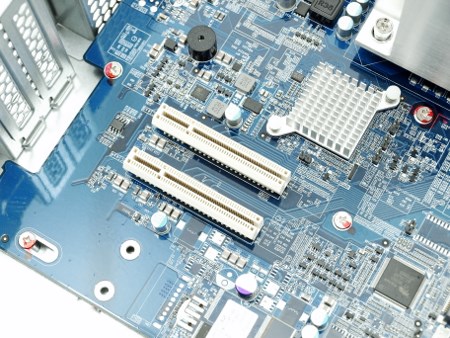THE TVS-871U-RP-I3-4G INTERIOR
The switching PSUs used are by Delta Electronics and offer up to 250W each with 20A on the +12v rail (if you don't care about the redundant feature you can give power only to one of the two and thus cut down on power consumption).
Now this is why we like rack mount NAS models so much since we're basically talking about regular PCs (the large heatsink is placed over the CPU).
QNAP has used a 512MB flash DOM from Apacer just like with most of their models.
With two available mSATA ports you can boost the performance of the unit to even higher numbers by adding mSATA flash modules (recommended mostly for 10GbE use however).
The TVS-871U-RP has two PCIe slots, one x4 and one x8 (pay extra attention to this because initially we had the 10GbE card plugged into the x4 one).
There are 4 memory slots on the mainboard two of which are taken by 4GB of DDR3 RAM running at 1600MHz (tried adding two extra modules but for some reason the ones we have here are incompatible).
With 3 AVC 70mm high-speed fans (and thus quite noisy) i really don't know why QNAP (and others with similar models) is using a fanless heatsink for the CPU.
10GbE tests require extra cards and for the review of the TVS-871U-RP we used the LAN-10G2T-U dual-port model by QNAP which makes use of the same XT540-AT2 10GbE Ethernet chip as the Intel card we got for our test rig.
Two 10GbE cards however is not enough, you also need a compatible switch and nothing beats the ProSafe XS712T 10G smart model by Netgear (offers 12 10GBase-T connections and 2 combo SFP+ 10G Fiber ports).
Of course we also got all the necessary CAT6a cables (CAT6a or CAT7 cables are required for 10GbE) and made use of our 6 Seagate Constellation ES.3 4TB SATA III drives (we could had used 8 or 4-6 SSDs to get even higher performance numbers but we've used up to 6 so far so that wouldn't be "fair" to our previous tests).

 O-Sense
O-Sense




















.png)

